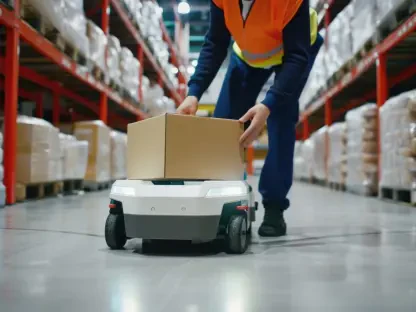In the rapidly evolving landscape of commercial transportation, the shift toward electrification stands as a defining challenge for fleet operators and manufacturers alike, with global pressure mounting to reduce carbon emissions. One company, Harbinger, a medium-duty electric vehicle (EV) manufacturer, has recently captured significant attention by securing a staggering $160 million in Series C funding alongside a landmark deal with a logistics giant. This roundup dives into the buzz surrounding Harbinger, exploring diverse perspectives from industry experts, investors, and fleet operators on what this milestone means for the future of sustainable trucking. The purpose here is to gather varied opinions and insights, shedding light on the implications of such developments for affordability, innovation, and scalability in the EV sector.
Funding and Partnerships: What Industry Voices Are Saying
A broad spectrum of stakeholders has weighed in on Harbinger’s recent financial boost, which has brought its total capital raised to an impressive $358 million. Many venture capital analysts highlight the diversity of investors—ranging from prominent firms like Tiger Global to sustainability-focused funds backed by major corporations—as a strong signal of confidence in the company’s vision. Some argue that this level of backing, especially from strategically aligned players, positions Harbinger to tackle the high barriers to entry in the medium-duty EV market, such as production costs and infrastructure challenges.
Contrasting views emerge when discussing the scale of this investment. While certain industry watchers applaud the $160 million as a catalyst for accelerating production, others caution that market adoption remains a hurdle. A segment of financial experts points out that despite the enthusiasm, the commercial EV space is still grappling with skepticism from smaller fleet operators who fear high upfront costs and unproven reliability. This divide in opinion underscores the need for tangible results to match the financial hype.
Adding another layer to the conversation, the initial order of 53 electric trucks from FedEx, comprising Class 5 and Class 6 models, has sparked discussions on partnership strategies. Logistics sector commentators note that aligning with a powerhouse like FedEx offers not just validation but also a real-world testing ground for Harbinger’s technology. However, some smaller logistics firms express concern that such high-profile deals might overshadow the needs of less resourced operators, raising questions about accessibility and equity in the electrification push.
Technology and Innovation: Diverse Takes on Harbinger’s EV Platform
Proprietary Design: A Game-Changer or a Risk?
Harbinger’s proprietary electric platform, which matches the acquisition cost of traditional combustion engine trucks, has drawn significant praise from technology analysts in the automotive space. Many emphasize the modular battery configurations, offering ranges from 140 to over 200 miles, as a practical solution for varied fleet needs. This affordability and flexibility are often cited as key factors that could drive wider adoption among cost-conscious operators looking to transition to electric without financial strain.
On the flip side, some engineering consultants express reservations about the long-term durability of such designs under heavy-duty conditions. Concerns linger around whether the balance of cost and performance can hold up against the wear and tear of daily operations. These critics suggest that while the concept is promising, real-world data over the coming years will be critical to proving the platform’s resilience compared to established diesel alternatives.
A third perspective comes from safety advocates who spotlight the inclusion of advanced features like backup cameras with dynamic trajectory. These additions, uncommon in medium-duty trucks, are seen as a step toward enhancing driver safety and reducing accident rates. Yet, there’s a caveat—some fleet managers worry that integrating these systems into existing operational workflows might require additional training and upfitting costs, potentially offsetting the initial savings.
Cross-Sector Applications: Broadening the EV Horizon
Beyond trucking, Harbinger’s technology is making waves in unexpected areas, such as the RV market with THOR Industries’ Entegra Coach launching a range-extended electric motorhome on its chassis. Industry trendsetters view this adaptability as a sign of emerging cross-sector potential, suggesting that EV platforms could redefine multiple vehicle classes. This versatility is often hailed as a way to amortize development costs across diverse markets, strengthening the case for investment.
However, opinions differ on the scalability of such applications. Some market analysts argue that niche segments like electric motorhomes may face limited demand due to regional variations in infrastructure, such as charging availability in rural areas. They caution that overextending into less proven markets could dilute focus from core trucking solutions, potentially risking investor trust.
A contrasting angle comes from sustainability advocates who see these expansions as a bold challenge to conventional thinking about EV limitations. By tackling range and cost barriers in varied vehicle types, Harbinger’s approach is often described as a blueprint for rethinking transportation design. This optimism, though, is tempered by calls for more data on consumer reception before declaring cross-sector success.
Strategic Alliances: FedEx Deal Under the Microscope
Performance and Cost: A Win for Logistics?
The partnership with FedEx has elicited a range of reactions, particularly regarding the trucks’ reported performance and cost-effectiveness for larger-capacity delivery operations. Logistics industry leaders frequently commend the alignment with FedEx’s goal of a fully electric fleet by 2040, viewing it as a benchmark for other companies. Many believe this collaboration could set a precedent for how performance metrics are evaluated in the shift to sustainable fleets.
Dissenting voices from smaller logistics entities highlight a potential gap in applicability. While FedEx’s scale allows for tailored testing and integration, some operators question whether the same cost benefits will translate to smaller fleets with tighter budgets. This concern points to a broader debate on whether high-profile partnerships inadvertently create a tiered system in EV adoption, favoring larger players.
Another viewpoint focuses on the role of investors like Ridgeline, which has ties to FedEx, in shaping this deal. Financial strategists suggest that such insider alignment ensures deeper insights into fleet needs, potentially smoothing the path for long-term collaboration. Yet, there’s a note of caution that over-reliance on specific partnerships could limit Harbinger’s flexibility to address diverse market demands down the line.
Industry Standards: Shaping the Future of Electrification?
Looking at the broader impact, many environmental policy experts see the FedEx deal as a catalyst for raising electrification standards across the industry. Comparisons to other sustainability initiatives reveal a growing trend of logistics giants driving change through strategic vendor relationships. This perspective often frames Harbinger’s role as a potential standard-setter for balancing innovation with practicality.
On the other hand, some industry consultants warn against over-optimism, noting that one partnership, however significant, does not guarantee widespread change. They argue that regulatory support and infrastructure development must keep pace with technological advancements to ensure equitable access to electrification benefits. Without these, the impact of such deals might remain localized to specific corporations.
A balanced take comes from fleet management advisors who suggest that while the collaboration is a strong proof of concept, its true test lies in scalability and replication. They advocate for detailed case studies post-deployment to assess how these trucks perform under varying conditions, which could inform future industry benchmarks. This pragmatic stance reflects a desire for data-driven progress over speculative enthusiasm.
Key Takeaways from the EV Discussion
Reflecting on the myriad opinions, several key themes emerge from Harbinger’s journey in the EV landscape. Competitive pricing and cutting-edge safety features are consistently highlighted as differentiators that could sway hesitant fleet operators. Additionally, the FedEx partnership serves as a tangible example of how strategic alliances can validate and scale new technologies, offering a model for others to emulate.
Fleet operators seeking to transition to electric can glean practical lessons from these insights. Evaluating total cost of ownership, beyond just acquisition price, remains a critical step in decision-making. Prioritizing safety features that reduce operational risks also stands out as a smart investment, potentially lowering insurance and liability costs over time.
Businesses of all sizes can draw inspiration from modular design approaches like Harbinger’s, which allow customization without exorbitant expenses. Exploring partnerships with EV innovators or tapping into sustainability-focused funding could further ease the financial burden of adopting green technologies. These strategies highlight a path toward sustainable operations that balances innovation with fiscal responsibility.
Reflecting on a Milestone in Medium-Duty EV Adoption
Looking back, the discussions around Harbinger’s $160 million funding and FedEx partnership revealed a dynamic mix of optimism and caution among industry stakeholders. The varied perspectives underscored the complexity of transitioning to electric fleets, balancing technological promise with practical challenges. Each opinion, from investor confidence to fleet operator concerns, contributed to a richer understanding of what electrification entails at this juncture.
Moving forward, stakeholders are encouraged to focus on actionable steps like advocating for supportive policies to bolster charging infrastructure, which remains a critical gap. Collaborating with manufacturers to pilot and refine EV solutions tailored to specific operational needs also emerges as a priority. These efforts promise to build on the momentum Harbinger ignited, paving the way for broader adoption.
Another vital consideration is the importance of sharing deployment data and outcomes transparently across the industry. Such knowledge exchange could help demystify the risks and rewards of EV integration, fostering trust and encouraging smaller players to join the movement. This collective approach hints at a future where sustainable transportation becomes not just an ambition, but a shared reality.









